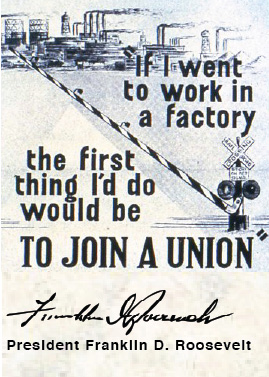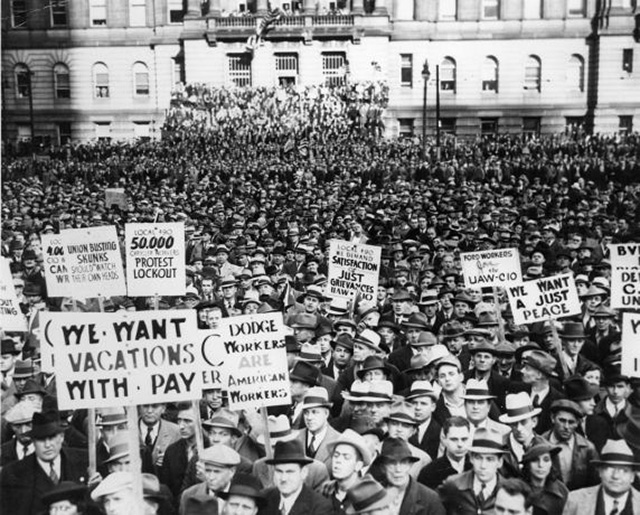
As the country struggled in the early 1930s to emerge from the depths of the Great Depression, few would have predicted that there would be successful unionization campaigns in the auto industry in late 1936 and early 1937. Memories of Ford’s heavy hand in the Hunger March of 1932 and the failure of a 1933 strike at a Briggs Manufacturing plant on Detroit’s east side underscored how difficult it was for workers to successfully challenge management. The 1934 strikes by San Francisco waterfront longshoremen, Minneapolis truck drivers, Toledo autoworkers, and textile workers in New England and the South had no counterparts in anti-union, “Open Shop” Detroit. A 1935 strike at Motor Products’ Mack Avenue plant ended in failure, due in part to the inability of competing unions to forge common ground.
Under the leadership of United Mine Workers president John L. Lewis, the Committee (later the “Congress”) of Industrial Organizations (CIO) was created in 1935, with the goal of organizing workers in the nation’s mass-production industries. Breaking with the practice of organizing only skilled workers based on their particular crafts, the CIO sought instead to organize all workers in an industry, skilled and unskilled, into the same union. The United Auto Workers (UAW) was part of the CIO movement, as were workers and organizers in the steel, electrical, coal, and textile industries, among others. Radicals of various persuasions as well as liberal activists filled the ranks of UAW organizers. The CIO and the UAW had a contentious relationship with the American Federation of Labor (AFL), which reluctantly backed industrial unions but preferred the old model of organizing only skilled workers. That model had made sense in the 19th century, but mass production in the nation’s industries, a development led by Henry Ford, had created an entirely new manufacturing system that relied heavily on unskilled workers who performed repetitive tasks. The classic AFL model of union organizing excluded those workers, who by the 1930s made up the vast majority of those employed in the industrial economy.

Support from the CIO in the 1936 U.S. presidential election helped sweep Franklin Roosevelt to a second term. Working-class Detroiters, black and white, also helped elect former Detroit Mayor Frank Murphy as governor of Michigan. Both Roosevelt and Murphy pledged to uphold the federal National Labor Relations Act (NLRA, also known as the Wagner Act), passed in 1935, which gave workers the legal right to form unions and prohibited employer interference in organizing campaigns.
Even after the November elections, however, most automakers ignored the NLRA and fought hard against unionization. In response, UAW organizers relied on a tactic, the sit-down strike, that had been used first by Akron rubber workers and then by a UAW local in South Bend, Indiana. Rather than walk off their jobs and set up picket lines outside their plants, sit-down strikers stayed inside their workplaces, shutting down production and daring the company to remove them or bring in strikebreakers to replace them. Detroit’s first sit-down strike took place in mid-November 1936 at Midland Steel on the city’s east side. A month later, members of UAW Local 174, under the leadership of future UAW president Walter Reuther and his brother Victor, occupied the Kelsey-Hayes plant at McGraw and Livernois in Southwest Detroit. Kelsey-Hayes was a major supplier of brake parts for the Ford Motor Company, and Henry Ford put considerable pressure on Kelsey-Hayes management to break the strike and resume production. Instead, a groundswell of community support and worker solidarity during a 14-day sit-down strike helped secure wage concessions from Kelsey-Hayes, though not formal recognition of the UAW. The partial victory came on Christmas Eve.
Local 174 then began organizing sit-down strikes at the General Motors (GM) Cadillac and Fleetwood plants in Southwest Detroit as part of the UAW’s nationwide effort to unionize the massive corporation. Although there was also UAW strike activity in Ohio, Missouri, Georgia, and Wisconsin, the major battleground was in Flint, Michigan, GM’s birthplace. There, a 44-day sit-down strike ultimately halted GM’s Chevrolet production and brought the automaker to the bargaining table. Many Local 174 organizers played prominent roles in the Flint campaign, which resulted in formal recognition of the UAW and a union contract, the foundation of collective bargaining. The most important gains that autoworkers struck for were the right to challenge heavy workloads, including those caused by speedups of the assembly line, and a seniority system to prevent arbitrary hiring and firing by foremen. The shocking developments in Flint seemed to herald a new era in labor-management relations.
 Cadillac Square Rally to Defend Sit-down Strikers (March 1937)
Cadillac Square Rally to Defend Sit-down Strikers (March 1937)
The UAW’s victory secured contracts at GM’s Cadillac and Fleetwood plants in Southwest Detroit. The impact went well beyond GM, as a wave of sit-down strikes in Detroit mobilized 35,000 workers and hundreds of thousands of supporters at more than a hundred factories and businesses. Sit-down fever swept downtown department stores and hotels, cigar factories, bakeries, laundries, and meat packinghouses as well auto plants. West Side Local 174 won contracts at many Southwest Detroit firms including: Detroit Timken Axle, Federal Motor Truck, Federal Screw, Michigan Malleable Iron, Revere Copper & Brass, Universal Cooler, and Universal Products. The UAW’s skilled trades Local 157 adopted the sit-down tactic to organize west-side tool-and-die shops like Buell Die and Machine, Star Tool and Die, and Koestlin. But soon headwinds appeared: management of the Connecticut based lock maker Yale and Towne secured an injunction against 150 sit-down strikers, mostly women. Four hundred Detroit police and sheriff deputies used clubs and tear gas to force the West Side Local 174 unionists from the plant. All employees were fired and within two months the Connecticut-based firm closed the facility and transferred production to other plants.
Despite that setback, UAW Local 174 had become a force to be reckoned with: it owned its own sound truck, a newspaper, and one of the largest rosters of organizers in the entire union. Its membership swelled from 78 people prior to the Kelsey-Hayes strike to 35,000 just four months later. Local 174 was the first local to purchase its own headquarters, a former Odd Fellows Hall on West Maybury Grand St. (now under the I-96 freeway). The Hall boasted a 150-seat auditorium, offices and meeting rooms, a kitchen, a bowling alley, and a billiard room. It hosted an extensive labor library and was home to a large mural, commissioned by Local 174 members and painted by Detroit artists Walter Speck and Barbara Wilson, that depicted major developments in the struggle for labor rights in the city. Speck and Wilson were inspired by Diego Rivera’s Detroit Industry Murals, located at the Detroit Institute of Arts. Although the Speck and Wilson mural depicted many union triumphs, including the first contract that covered Local 174 membership, the painting also portrayed the brutal assault in May 1937 on UAW organizers by Ford security personnel outside the Rouge Plant. Ford successfully resisted unionization until 1941.
 Police end Yale & Towne sit-down strike (1937)
Police end Yale & Towne sit-down strike (1937)
Click to view:
The Tide Turns, Steve Babson’s overview of the Detroit sit-down strikes of early 1937, excerpted from Working Detroit
Victor Reuther – Labor Minute, this DPTV / WTVS video introduces the Kelsey-Hayes strike
The Kelsey-Hayes Sit-down Strike, UAW retiree Jim Ward’s Michigan Labor History Society newsletter reflection on the 1936 strike that preceded the strike against GM
The Women of Ternstedt and the “First Slowdown” Strike, David Elsila’s Michigan Labor History Society newsletter recounts the unique tactics that forced this GM parts supplier to recognize the UAW at a moment when the sit-down strike was no longer a viable tactic.
Ford Takes on the Union: The Battle of the Overpass, this Michigan Labor History Society newsletter feature recounts the attempt of UAW organizers to distribute flyers to Ford workers
Profiles of these early UAW Local 174 activists:
Walter Reuther Victor Reuther George Edwards Stanley Nowak
Labor Perspective, David Elsila’s introduction to the Guide’s exploration of labor history is recommended reading for those who have not already done so. Other discussions that chronicle the challenges confronting workers and highlight organized labor’s accomplishments in the course of Detroit’s auto century are accessed most easily from the Guide’s Labor Roots page.
TEXT & RESEARCH– RON ALPERN
PHOTO CREDITS
Walter P. Reuther Library, Archives of Labor and Urban Affairs, Wayne State University
Cadillac Square Rally, UAW leaflet, Yale & Towne sit-down



